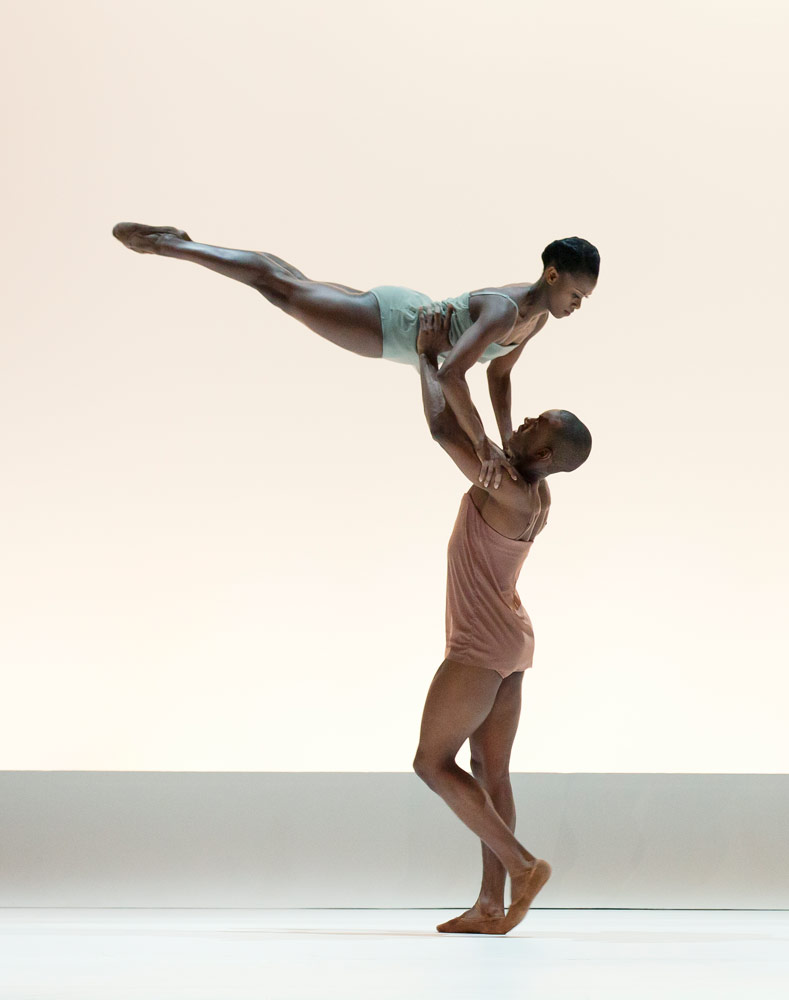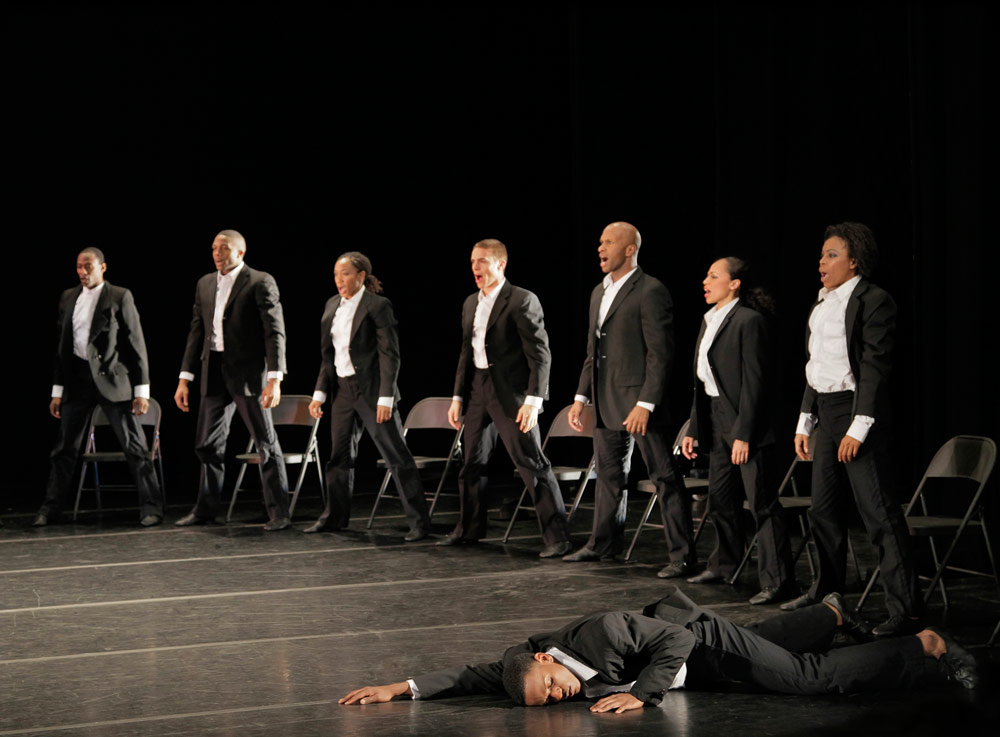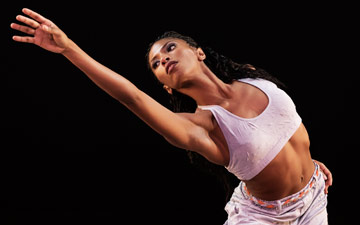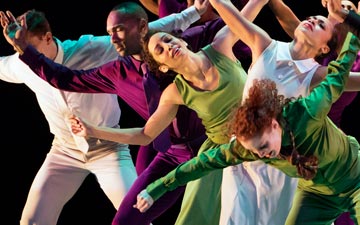
© Paul Kolnik. (Click image for larger version)
Alvin Ailey American Dance Theater
Program A: Chroma, The Pleasure of the Lesson, Revelations
Program B: Grace, Awassa Astrige/Ostrige, D-Man in the Waters (part I), Minus 16
New York, David H. Koch Theater
14, 15 June 2014
www.alvinailey.org
Dancing in the Aisles
Since becoming artistic director at Alvin Ailey American Dance Theater in 2011, Robert Battle has been steadily mixing up the company’s repertory, adding works by choreographers beyond its usual range: Paul Taylor, Ohad Naharin and Wayne McGregor, to name just three. Clearly the aim is to stretch the dancers and give them new ways to move and new attitudes to portray. But as a secondary consequence, it has been fascinating to see how these choreographers’ works are in turn transformed by the Ailey dancers. They don’t just do the steps, they mold them to their style and personality.
The current season, Ailey’s second spring run at the Koch Theatre in Lincoln Center, includes Chroma, by the British choreographer Wayne McGregor, Resident Choreographer at the Royal Ballet since 2006. Created that same year, Chroma is his best-known work, and, out of the four or five I’ve seen, the most tightly constructed. McGregor’s style – now spiky, now aggressive, now sinuously extreme – has become increasingly familiar from his collaborations with various ballet companies as well as with his own modern-dance troupe, Random Dance. It’s not a particularly subtle style – legs are yanked around, bodies pushed to the floor or swung or twisted and torqued at various ungainly angles – but it’s exciting and contemporary-feeling and shows the dancers for the glamorous, impressive physical specimens that they are.
What the Ailey dancers add to the choreography – here performed off-pointe – is a kind of jazzy attitude; the dancers’ knowing looks and swagger infuse it with a clubby feel of one-upmanship and even, at times, a sense of play. A male trio, all shoulder twists, jutting hips and swishing arms, looks like a vogueing competition. The shapes are softer, rounder, more sexy than extreme. And because the women are off-pointe and often nearly as tall as the men, the power dynamic between the genders is more evenly matched than when the work is performed by a ballet company. As a showcase of the dancers’ prowess, it’s very effective. Sarah Daley, a relatively new recruit, is particularly impressive in a slow, stretchy pas de deux set to a melancholy piano melody – a respite from the mostly loud, clanging score by Jack White and Joby Talbot – in which each position of the legs is clearly etched, the transitions smooth and elegant.

© Paul Kolnik. (Click image for larger version)
New this season is The Pleasure of the Lesson by the San-Francisco-based Robert Moses (his first work for the company). Though structurally discontinuous – it seems to move from image to image with little connective tissue – the work is full of striking motifs. Many seem to allude to the relations between men and women. The dancers face off in lines, women on one side, arms crossed, men on the other. A woman drowns beneath a sea of men; another glides across a carpet of male chests. Yet another is carried off, as if in a funeral cortege. A section has hints of West African movement, wing-like arms, back-muscles rippling; another draws on the sensual hips of salsa. It’s all a bit mysterious. The score, a collage of sounds, beats, bells, vocalizations and whispered words – by Moses and David Worm – is equally opaque. But the inventiveness of the movement, and the genuine heat generated by the dancers, holds one’s interest.
On another program, the tall, lithe Yannick Lebrun danced a short solo, Awassa Astrige/Ostrich, by the African-dance pioneer Asadata Dafora, one of the very first choreographers to present traditional West African dance to American audiences. Bare-chested and wearing a skirt of feathers, a man glides across the stage on bent legs, arms and back rolling and rippling, head pivoting sharply side to side like a bird. The solo is all about the fluidity and articulation of the back, the sensuality of the pelvis, and, let’s face it, the undeniable beauty of the man performing these perfectly-controlled movements. Dance anthropology meets exoticization. But then, something similar is at play in The Dying Swan, its balletic equivalent, with which it has much in common. The dancer, depicting an idealized version of animal movement, becomes a divine object to be admired and desired.

© Paul Kolnik. (Click image for larger version)
The coexistence of the divine and the profane is also the subject of Ronald K. Brown’s Grace (1999), performed on the same program. Grace opens and closes with Duke Ellington’s “Come Sunday” – “god of love, please look down and see my people through” – accompanied by a prayerful dance, performed first by the grave, authoritative Linda Celeste Sims and finally by the whole ensemble, all in white. Repentance and atonement are the bookends, but the road to grace is anything but somber. The beat-heavy club music and Afro-pop of the middle sections is the backdrop to Brown’s sinuous, full-body movement, a seductive amalgam of urban club dance, African dance, and capoeira. Everything looks relaxed, connected, and full. Few choreographers use the body in such a three-dimensional way. The ensembles are just as supple and fluid. Dancers enter and exit like tides, demarcated by the fluid red and white costumes; groups subdivide, re-convene, change direction like birds in flight. The Ailey dancers are completely in their element here; Matthew Rushing, in particular, seems to move in a state of blissful ease. This is dancing as pure pleasure. Atonement can wait.
Two recent company premières – Ohad Naharin’s Minus 16 and Bill T. Jones’ D-Man in the Waters, part I – also returned. D-Man (1989), a defiant response to the ravages of the AIDS epidemic,looks a little bit over-cheerful, more so than when it is danced by Jones’s own company. On the other hand, the Ailey dancers manage to make the end of Naharin’s deadpan Minus 16 (1999) – in which audience-members are led to the stage to perform alongside the company – feel like an act of inclusion, rather than a painful exercise in humiliation.

© Paul Kolnik. (Click image for larger version)
Like so many evenings before it, the June 14 program ended with Revelations, Alvin Ailey’s signature work from 1960. Performances vary in intensity, but Revelations, like Paul Taylor’s Esplanade and Jerome Robbins’ Fancy Free, always works its magic. Something about the Koch theatre – its imposing size and modernist formality, perhaps – inhibited the audience from whooping and clapping along as they often do at City Center. But as the final notes of “Rocka my Soul” rang out, the audience leapt to its feet. The company obliged with an encore, as it always does, and something unusual happened: the graying Lincoln Center audience started to dance in the aisles. When I left, they were still dancing.

















You must be logged in to post a comment.